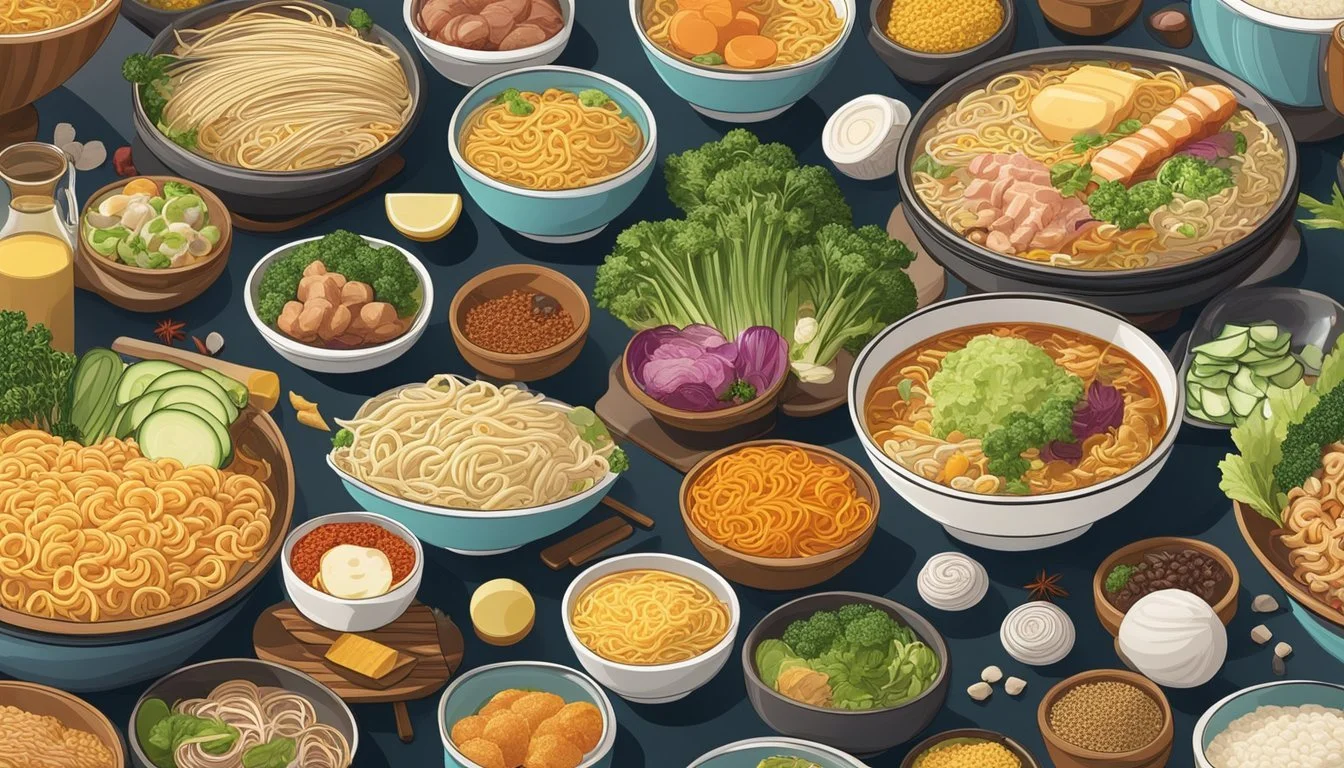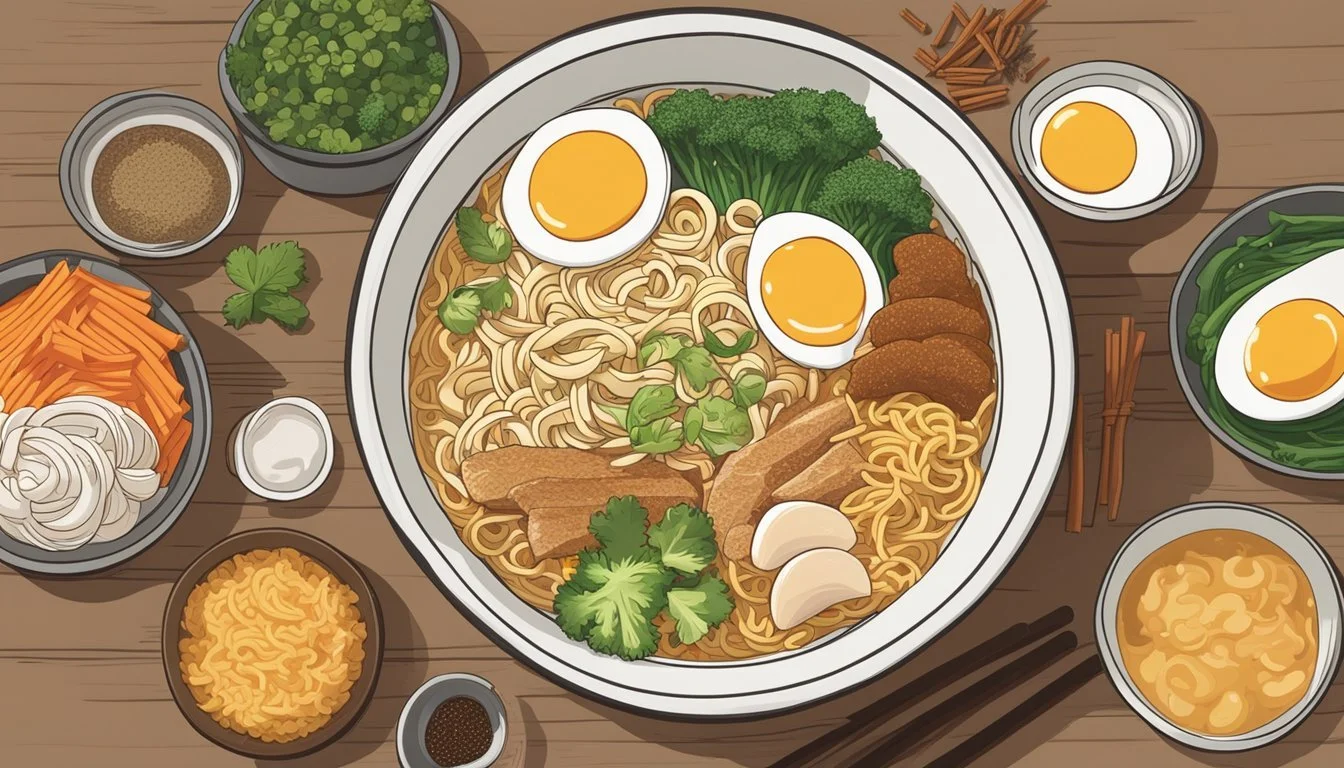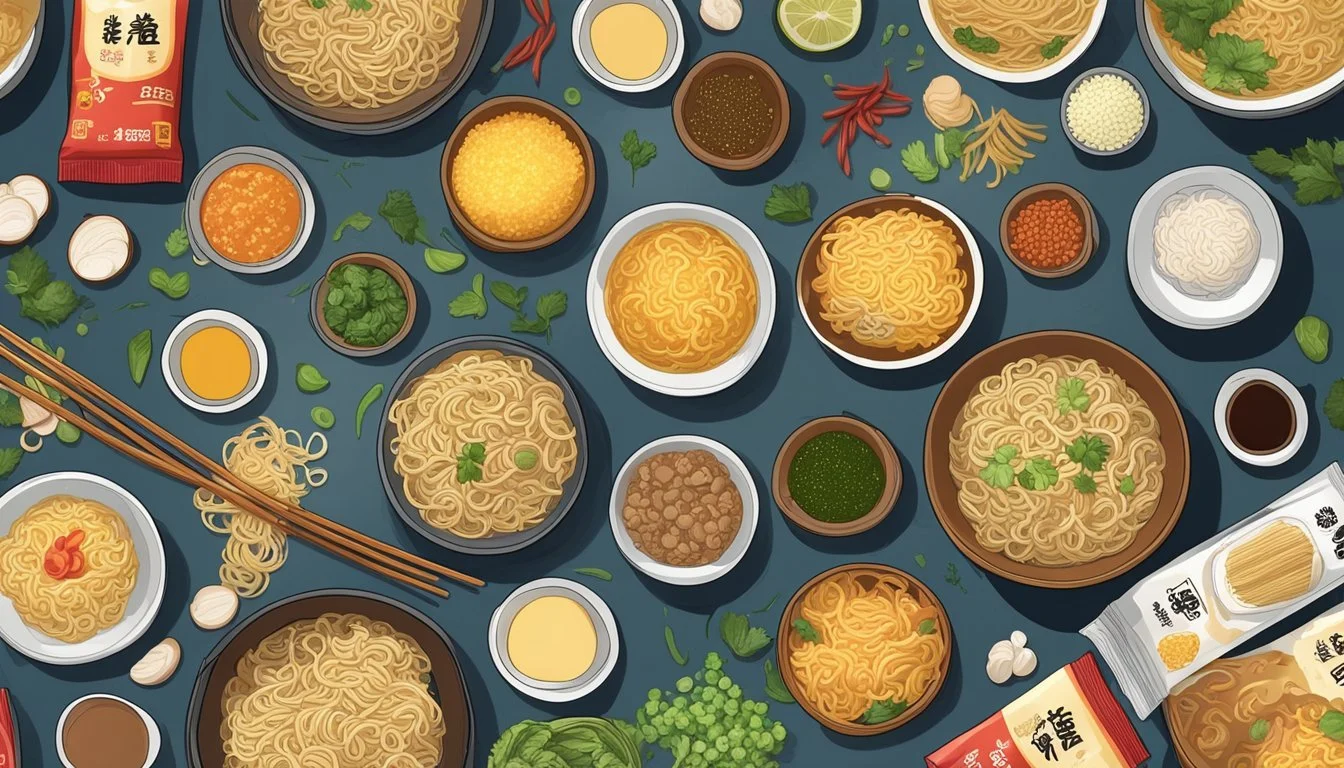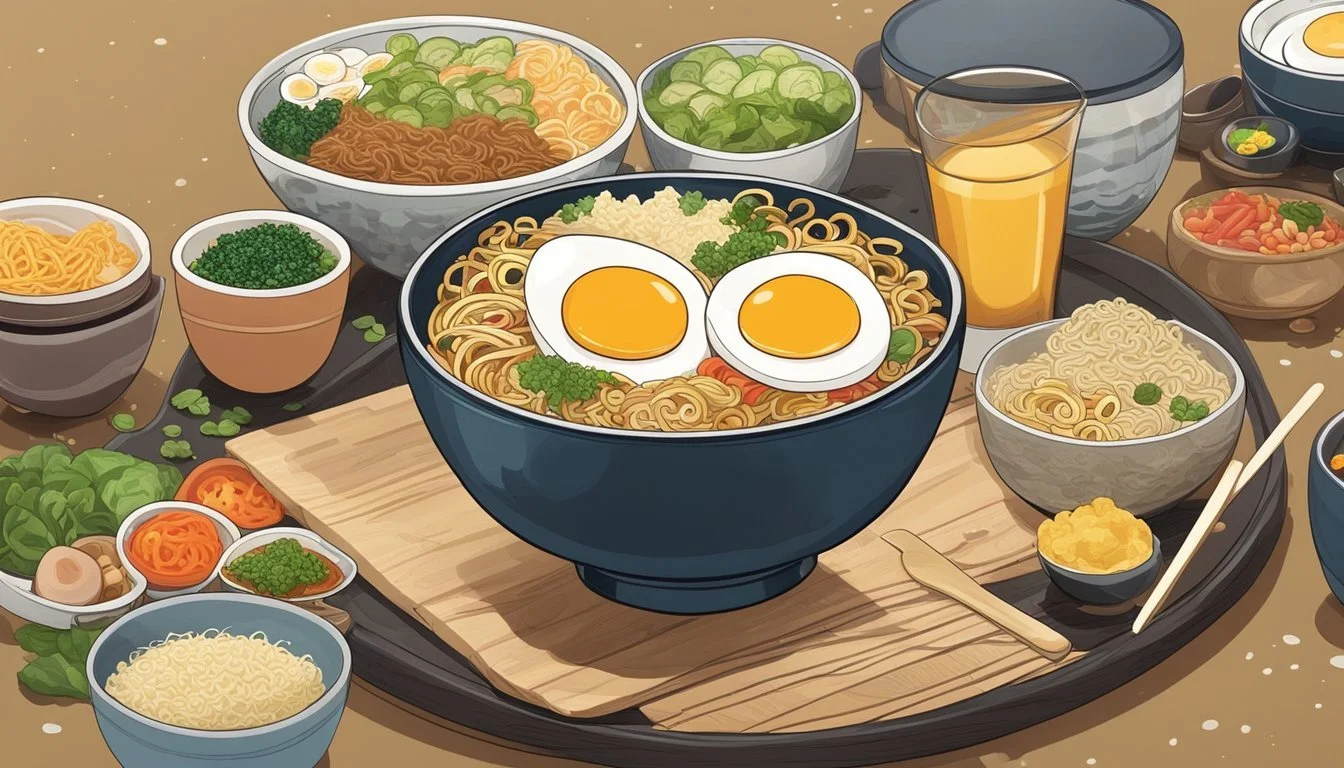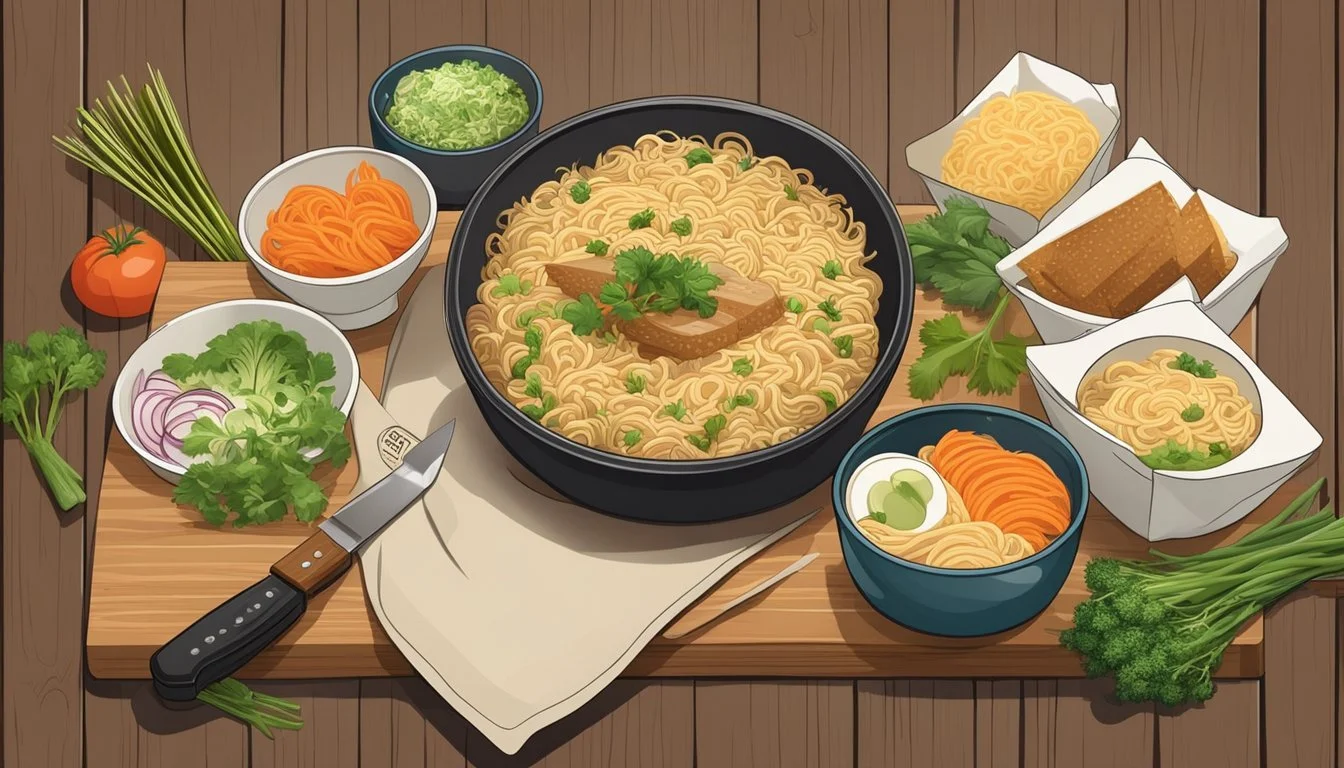Instant Ramen Noodle Makeovers
Quick and Tasty Upgrades for Your Favorite Comfort Food
Instant ramen noodles have long been the staple for quick meals, offering a convenient and comforting bowl of broth and noodles with minimal effort. Despite their simplicity, these pre-packaged noodles hold a wealth of potential for transformation into gourmet experiences. By incorporating a variety of ingredients and employing simple cooking techniques, one can elevate the humble packet of ramen into a dish that boasts complexity and depth of flavor.
Food enthusiasts and savvy cooks have embraced the art of ramen makeover, treating the noodles as a blank canvas for culinary creativity. Whether it's by adding proteins such as a soft-boiled egg or tender slices of pork belly (What wine goes well with pork belly?) , or by enhancing the broth with spices, vegetables, or aromatics like garlic, each addition brings a new dimension to the standard bowl of instant ramen. The outcome is a testament to the versatility of instant noodles and the endless possibilities that come with an adventurous approach to cooking.
History of Instant Ramen
Instant noodles, commonly referred to as instant ramen, were created in a post-war context when food shortages plagued Japan. Momofuku Ando, the inventor of instant noodles, first brought this revolutionary comfort food to market in 1958. As a Taiwanese-Japanese businessman, Ando sought a solution to feed the masses efficiently and affordably with this innovative product.
Instant Ramen Development:
1958: Ando succeeds in inventing instant ramen.
Quality: Prioritizes shelf-stable and easily rehydratable noodles.
Instant ramen's popularity quickly rose, thanks largely to its convenience and the comforting quality that came with a warm, flavorful bowl of noodles. It represented a snapshot of both culinary innovation and post-war necessity merging into a product that would eventually gain international acclaim.
Ramen vs. Instant Noodles:
Ramen: Traditional Japanese dish, more complex and varied.
Instant Noodles: Simplified, quicker version aiming for broader accessibility.
While instant noodles are different from real ramen, which often boasts intricate broths and fresh ingredients, they serve as a homage to this staple of Japanese cuisine. Instant ramen became not only a solution to Japan's immediate post-war food crisis but also a platform for creative food makeovers across the globe. As comfort food, its appeal spans ages and cultures, offering a canvas for culinary artistry or a simple, soothing meal.
Nutritional Profile
Instant ramen noodles often come under scrutiny for their lack of essential nutrients and high sodium content. A typical serving of instant ramen can have over 800 milligrams of sodium—which is around a third of the recommended daily intake. However, they can also serve as a canvas for nutritional enhancement.
To boost their healthful qualities, one can incorporate proteins such as chicken or eggs, increasing not only the protein content but also adding essential amino acids required for muscle repair and growth. Ramen can also be a source of B vitamins when enriched with select ingredients.
Vegetables offer an additional avenue for nutritional overhaul. Adding ingredients like spinach, carrots, or mushrooms can substantially increase the fiber, vitamins, and minerals in the meal, with benefits such as improved digestion and enhanced immune function.
Modifying the contents of the seasoning packet or the way it is used is another effective method. By using just a portion of the packet, or substituting it with low-sodium alternatives, one can significantly decrease the sodium content, resulting in a healthier dish.
Healthy preparation methods tend to favor fresher components over processed ones and emphasize balance. The transformation from a simple bowl of noodles to a more rounded meal is not only possible but also simple to achieve. As awareness of healthy eating grows, so does the creativity in redefining the culinary potential of these noodles.
Types of Instant Ramen
Instant ramen comes in various broth flavors, noodle styles, and regional tastes, catering to a wide spectrum of preferences. These variations transform the simple noodle pack into a culinary canvas.
Broth Varieties
Instant ramen broths are primarily categorized by their base flavors, which include:
Shoyu (Soy Sauce): A salty and umami-rich option, shoyu is often the default for many ramen varieties.
Miso: Made from fermented soybean paste, miso broth offers a complex flavor that is sweet, salty, and rich in umami.
Tonkotsu: This broth is based on pork bones, boiled until they release a creamy, white soup that is hearty with deep flavors.
Shio (Salt): A lighter, clearer broth that highlights the natural flavors of its ingredients.
Vegan ramen typically comes with broths derived from vegetables or mushrooms to provide a rich umami experience without any animal products.
Noodle Styles
Instant ramen noodles vary in thickness and texture:
Thin and Straight: Commonly found in traditional shoyu and shio ramen.
Thick and Wavy: Often paired with miso or tonkotsu broths to absorb more flavor.
Regional Flavors
Apart from the standard varieties, instant ramen also embraces regional flavors that represent local cuisines:
Hokkaido Ramen: Known for its miso-based soup enriched with butter and corn.
Kyushu Ramen: Features tonkotsu broth with a characteristic cloudy appearance and robust taste.
Tokyo Ramen: Typically exhibits a shoyu-flavored base, reflecting the prevalent soy sauce usage in the region.
Customizing Your Instant Ramen
When elevating a simple bowl of instant ramen, one can introduce high-quality proteins, a variety of vegetables, and a dynamic range of spices to transform it into a nutritious and flavorful meal.
Adding Proteins
Chicken: Shredded chicken breast adds a lean source of protein. It can be cooked separately and then mixed in with the cooked noodles.
Beef: Thinly sliced beef can be quickly stir-fried and combined with the ramen for a more filling dish.
Eggs: Eggs, whether soft-boiled, poached, or whisked into the broth egg-drop style, bring richness and texture to the soup.
Seafood: Including shrimp or fish paste such as narutomaki introduces a seafood twist.
Tofu: Tofu is a great alternative for those seeking a plant-based protein option.
Pork Belly/Bacon: For a richer flavor, one can add crispy bacon or slices of succulent pork belly.
Vegetable Boost
Leafy Greens: Bok choy, spinach, and cabbage offer a nutritious touch. They can be sautéed or added directly to the broth to wilt.
Mushrooms: A variety of mushrooms like shiitake or cremini add earthiness and are best added to the broth to absorb flavors.
Bean Sprouts and Peas: Snap peas, snow peas, or bean sprouts can be tossed in for crunch.
Broccoli: Florets of broccoli add texture and are best blanched before joining the ramen mix.
Seaweed/Nori: Torn pieces of seaweed or nori add a salty, oceanic flavor and can be used as a garnish.
Spice It Up
Garlic and Ginger: Minced garlic and ginger sautéed before adding the broth create a fragrant base.
Scallions: Chopped scallions offer a mild onion flavor and a pop of color.
Pepper: A dash of white or black pepper can be sprinkled on top for heat.
Spices: For those desiring more intensity, spices like chili flakes, cayenne, or even a dollop of spicy kimchi can revamp the heat level.
Vegan Options: Vegan diners can substitute meat-based broth with vegetable stock and add vegan kimchi for complexity.
Creative Toppings and Add-ins
Transforming instant ramen into a gourmet meal is all about the toppings. One can elevate the humble noodle dish by adding a variety of toppings and garnishes, from classic essentials to innovative delights.
Classic Toppings
Soft-Boiled Eggs: An essential accompaniment, soft-boiled eggs with their creamy yolks add richness to the broth. Hard-Boiled Eggs: A hard-boiled egg ensures a firmer texture and can be sliced or quartered for easy consumption.
Pork Belly: Succulent and flavorful, it provides a hearty addition.
Chicken: Both breast and thigh pieces serve as a lean protein option.
Seafood: Shrimp or crab sticks are common for adding a taste of the ocean.
Greens: Corn and peas infuse color and a sweet crunch with each bite.
Furikake: This Japanese seasoning brings in umami from mixed seaweed, sesame seeds, and various spices.
Crispy Fried Onions: They offer a delightful crunch and oniony sweetness.
Innovative Garnishes
Kim (Seaweed): Sheets of nori or seasoned seaweed can be cut into strips and added just before serving for a fresh marine hint.
Cheese: A slice of American cheese melts into the hot broth, creating a creamy, indulgent texture.
Butter: A pat of butter can be melted into the soup for added richness.
Sesame Seeds: Toasted sesame seeds bring a nutty flavor and aesthetic appeal.
Seasonings: Ingredients like yuzukosho or a spicy pepper mix introduce a complex and bright taste profile.
These additions can help one's instant ramen bowl mimic a more authentic ramen experience. The beauty lies in the ability to customize to personal preference, making every bowl uniquely satisfying.
Upgrading the Broth
Transforming the broth can elevate instant ramen into a more sophisticated dish. One can begin by substituting water with chicken broth or miso broth to infuse a rich base flavor. To deepen the umami flavor, ingredients like soy sauce, fish sauce, or miso paste can be integrated.
Broth Variations
Traditional Umami: Enhance with a tablespoon of soy sauce and a teaspoon of sesame oil.
Spicy Kick: Stir in a dollop of harissa or a spoonful of red curry paste for heat.
Sweet and Sour: Balance with a mixture of sugar, vinegar, and lime juice.
Specialty Broths
Vegan Delight: Use a vegan broth and add tahini or ground sesame seeds.
Creamy Coconut: Combine coconut milk with red curry paste for a Thai-inspired twist.
Flavor Boosters
Miso Magic: A swirl of miso paste can offer a traditional Japanese taste.
Nutty Essence: Peanut butter adds a creamy texture and a nutty flavor profile.
Balancing flavors is key; one must measure additions carefully to avoid overpowering the broth. Whether seeking a hint of sweetness, a touch of sourness, or a fiery spice, the right combination can be achieved with a confident hand and knowledgeable adjustments. The final result should be a harmonious and satisfying broth that complements the noodles and additional toppings.
Seasonings and Sauces
Transforming instant ramen begins with a masterful manipulation of seasonings and sauces. One can slowly build layers of flavor starting with the foundational seasoning packet that accompanies the noodles. However, the culinary adventurous may choose to set aside the provided seasonings in favor of a more customized palette of tastes.
Begin with soy sauce and sesame oil for a classic, umami-rich base. A dab of miso paste or a dash of fish sauce can further deepen the flavor profile, adding a complex fermented note. Those seeking a bit of heat might stir in sriracha or chile flakes, while a pinch of Sichuan pepper introduces a numbing zest.
For a brighter edge, a touch of vinegar or lime juice offers acidity, cutting through the richness of the dish. The addition of sugar can balance the tanginess, creating a harmonious blend. To elevate the dish further, consider incorporating Japanese mayo for creaminess or tamari for a gluten-free soy sauce alternative.
Table: Suggested Pairings for Sauces and Seasonings
Foundation Enhancer Zest Sweetener Creaminess Heat Soy Sauce Miso Lime Juice Sugar Japanese Mayo Sriracha Sesame Oil Fish Sauce Vinegar Tahini Chile Flakes Seasoning Packet Sichuan Pepper White Pepper
When one opts out of the seasoning packet, remembering to season with salt and pepper to taste is vital. Experimenting with the intensity and ratios can yield an instant ramen dish that's far from ordinary, satisfying even the most discerning palates.
Healthy Alternatives
When seeking healthier versions of instant ramen noodles, one can explore low-sodium options, incorporate abundant vegetables, and add protein to enhance the nutritional value without compromising on taste.
Low-Sodium Options
Reduced sodium in ramen can be achieved by substituting traditional seasoning packets with homemade broth or using low-sodium prepared broths. One can create their own seasoning blend with garlic powder, a pinch of salt, and other preferred spices. This method allows for control over sodium levels while still enjoying the essence of ramen.
Vegetable-Forward Recipes
Vegetables can transform instant ramen into a nutritious meal. Adding a mix of broccoli, cabbage, snap peas, snow peas, cauliflower, spinach, or kale not only boosts fiber intake but also enhances the flavor profile. One can either stir-fry the vegetables before adding them to the noodle soup or simmer them directly in the broth to infuse it with their essence.
Protein-Packed Variations
Incorporating protein into ramen noodles is a simple way to make the meal more filling and balanced. Lean proteins such as chicken, beef, or shrimp are excellent options. For vegetarian alternatives, tofu or a soft-boiled egg can provide both protein and texture. These protein sources can be seasoned and cooked separately, then added to the ramen to maintain integrity and flavor.
By prioritizing low-sodium alternatives, highlighting vegetables, and including quality protein sources, one can easily give instant ramen a healthful makeover.
Meal Planning with Instant Ramen
Instant Ramen noodles offer a quick and customizable foundation for a variety of meals, allowing one to incorporate proteins, vegetables, and other nutritious ingredients effectively.
Lunch Ideas
For a protein-packed lunch, boil water with part of the seasoning packet, add noodles until tender, and whisk a beaten egg into the simmering broth. A handful of baby spinach will add freshness and vitality to this comfort meal. The recipe transforms into a filling lunch with minimal effort and time.
Protein Boost: Add cooked, shredded chicken or tofu cubes.
Greens: Include spinach, bok choy, or kale for a nutrition boost.
Quick Dinners
An evening meal can turn into a quick dinner with Kimchi Ramen. One starts by boiling water with half of the seasoning packet. Once the noodles loosen, they whisk in eggs and continue cooking until done. Tasting and adding more seasoning to meet one's preference is essential.
Flavor Variation: Incorporate red curry paste or a touch of fish sauce.
Vegetables: Sauteed mushrooms, carrots, or Chinese cabbage can add texture and nutrition.
Bulk Preparation
Meal planners can create multiple servings of ramen by bulk preparation. By sauteing common aromatic vegetables like onions and garlic before boiling the water, one can prepare a ramen base that is both comfort food and a healthy option. Frozen vegetables, such as broccoli and a mixed variety, along with tofu, can be added for a more substantial dish.
Storage: Divide into portions and refrigerate for easy reheating.
Next Meal Ready: Cook noodles only until al dente to prevent sogginess when reheating.
Instant Ramen Around the World
Instant ramen, a pantry staple with its roots in Asia, has been creatively adapted across the globe. These versatile noodles serve as a canvas for an endless array of flavors and ingredients, reflecting regional tastes and culinary practices.
North American Twists
In North America, instant ramen embraces comfort and convenience. It's not uncommon to find a recipe that includes American cheese, creating a simple yet indulgent dish. For a heartier meal, they might add corned beef, scallions, and onions to the noodles, dressing up the humble packet with vibrant flavors and textures. Ramen recipes here often merge assorted cuisines, producing unique homemade ramen variations.
Asian-Inspired Variations
Asian countries, where ramen hails from, offer a wide spectrum of ramen recipes that align closely with their rich culinary heritage. Japanese instant noodles, known for their slight chewiness and seafood-infused broths, are typically enjoyed with toppings like eggs and baked chicken. Korean ramen packs heat with spicy seasonings and kimchi, while Chinese adaptations may include stir-fried vegetables and proteins, harmonizing with traditional Chinese flavors. These homemade versions reflect the authentic spirit of Asian cuisine.
European Influences
On the European front, instant ramen is often seen as a quick eat yet is still tailored to local tastes. European influences might not be as pervasive in the world of ramen, but they do exist in the incorporation of local ingredients such as mushrooms, cabbage, or regional spices to create a dish that resonates with local palates. Each European country can put its own spin on ramen, adapting the basic recipe to fit their dietary preferences.
Storage and Shelf Life
When it comes to maximizing the shelf life of instant ramen noodles, proper storage is key. Sealed packets of instant ramen noodles should be kept in a cool, dry area of the pantry, away from direct sunlight and moisture, which can degrade quality and shorten shelf life.
The typical shelf life of instant ramen noodles, when stored correctly, can extend several months past the printed expiration date. Here are general guidelines for pantry storage:
Unopened instant noodle packets: Up to 6 months after the expiration date.
Seasoning packets: Use by the noodle’s expiration date to ensure flavor integrity.
To maintain the best quality, they should not be exposed to extreme temperatures. Seasoning packets often contain dehydrated vegetables, which last much longer, but for optimal taste, they should be used alongside the noodles before the expiration date.
For those who purchase fresh instant noodles rather than dried, the refrigerator is the proper storage location. Fresh ramen noodles may last:
1-2 weeks in the refrigerator
Remember, these timelines are for optimal taste and safety; noodles can sometimes be consumed beyond these periods if they have been stored correctly and show no signs of spoilage. However, they may exhibit textural changes and less vibrant flavors. Always inspect noodles and consult the expiration date before use.
Understanding Ramen Labels
When selecting instant ramen, customers should pay close attention to the labels on the packaging. They often provide crucial information about the contents and nutritional value of the product.
Ingredients List: This section details everything included in the packet. Instant ramen typically contains noodles, a soup base, and occasionally a seasoning oil packet. It's important for consumers to check for any potential allergens or ingredients that they may wish to avoid.
Nutrition Facts: This label displays serving size, calories, and other nutritional data. Instant ramen is known for its high sodium content, so those monitoring their salt intake should check this section carefully.
Cooking Instructions: A vital part of the label, it provides a step-by-step guide on how to properly prepare the noodles. While preparation is generally straightforward, some brands may include additional steps for optimal taste.
Expiration Date: It's essential for ensuring the product's freshness and safety. Consumers should verify the date to ensure they are consuming the ramen within a suitable timeframe.
Flavor Profile: Sometimes indicated on the front of the package, it describes the type of ramen broth—be it shoyu (soy sauce), miso, shio (salt), or other varieties—and can hint at the intensity and depth of flavor.
Special Labels: These include 'Non-GMO', 'Vegan', or 'No MSG', among others, catering to specific dietary preferences and requirements.
Below is a simplified label snapshot for clarity:
Section Purpose Ingredients List Identifies all components of the ramen. Nutrition Facts Lists nutritional content and serving size. Cooking Instructions Describes how to prepare the ramen. Expiration Date Tells when the ramen is no longer optimal to eat. Flavor Profile Gives an overview of the broth type and taste. Special Labels Indicates dietary accommodations or certifications.
By understanding these labels, consumers can make informed choices about which instant ramen products best suit their tastes and dietary needs.
Ramen in Popular Culture
Ramen, particularly instant ramen, has cemented its status in pop culture. Its frequent appearances in various media channels have transformed it from a quick meal option to a cultural icon. Television shows and movies from around the world feature characters slurping down bowls of steaming noodles, depicting ramen as a comfort food that evokes a sense of nostalgia and warmth.
Anime and Manga are leading forces in showcasing the deep significance of ramen within Japanese society. Titles such as "Naruto" have introduced viewers to the delights of ramen through iconic eateries like the Ichiraku Ramen shop, influencing fans to explore this cuisine.
In the music industry, ramen has also been referenced in lyrics, signifying its relevance in everyday life experiences. The instant ramen variant, with its ease of preparation and affordability, further resonates with a broad spectrum of individuals, from college students to busy professionals.
Year Milestones in Ramen Popularity 1960s Introduction of instant ramen in Korea 20th Century Evolution of ramen into a sophisticated dish Present Ramen-themed restaurants and festivals worldwide
The crossover of ramen into Western culture has led to the emergence of ramen-themed restaurants and food festivals. This integration reflects ramen's universal appeal and adaptability, making it a beloved dish without cultural boundaries.
Blogs and social media platforms teem with posts about ramen, where individuals share creative recipes, expressing the versatility of this dish. In essence, ramen's presence in popular culture continues to grow, inviting people to partake in its culinary evolution.
DIY Instant Ramen Hacks
Elevating instant ramen noodles to homemade ramen quality can be accomplished with a few clever tweaks to the seasonings and noodles. These DIY hacks focus on enhancing flavor and texture to transform the quick dish into a more satisfying meal.
Homemade Seasoning Mixes
Creating homemade seasoning mixes allows for control over flavor profiles and ingredient quality. Here's a basic recipe for a versatile ramen seasoning mix:
Ingredients:
1 tablespoon onion powder
1 tablespoon garlic powder
1 teaspoon ground ginger
1 teaspoon black pepper
1 tablespoon smoked paprika
1 tablespoon dried chives or green onion
Optional: 1 teaspoon sesame seeds
Mix all the ingredients in a small bowl until well combined.
One can tailor this blend to taste preferences, adding more heat, savory notes, or tang as desired. Simply sprinkle this mix over cooked noodles, stir into broth, or use it as a base for developing other complex flavors.
Making Fresh Noodles
For those seeking an alternative to the pre-packaged noodles, making fresh noodles can be a rewarding endeavor. The key to achieving the right texture is the balance of flour and water. Here's a basic recipe:
Ingredients:
2 cups all-purpose flour
2/3 cup water
1/2 teaspoon salt
Combine the flour and salt in a large mixing bowl.
Gradually add water, stirring with chopsticks or a fork until a dough starts to form.
Knead the dough for 5-10 minutes until it becomes smooth.
Cover with a damp cloth and let it rest for 30 minutes.
Roll the dough out thinly and cut it into strips to mimic the shape of ramen noodles.
Fresh noodles can be cooked immediately in boiling water or stored in the refrigerator for short-term use. When boiled, fresh noodles offer a heartier and more authentic texture, which elevates the entire dish.
Conclusion
The transformation of instant ramen products reflects a broader consumer demand for convenience matched with sustainability and health consciousness. Nissin’s Cup Noodles has recently updated its half-century-old packaging to paper materials in 2024, indicating a shift towards environmentally friendly practices without compromising the familiar taste and ease of preparation consumers expect.
Healthier recipes for instant ramen incorporate ingredients like chicken and vegetables, increasing essential nutrients such as vitamins and protein while keeping fat content low. It's clear that the instant ramen industry is responding to a clientele that values both health and eco-friendly packaging, yet does not want to let go of the quick and easy comfort provided by these noodles.
In summary:
Packaging: Paper cups introduced for Cup Noodles in 2024
Health Improvements: Enhanced recipes with chicken and vegetables to boost nutritional content
Preparation: Straightforward process remains a key attribute, with clear instructions maintaining ramen's convenience
Instant ramen's innovation and adaptability ensure its place in the global market continues to be as secure and significant as ever.

